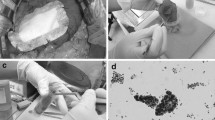Abstract
Inadvertent perforation or incision into rectal carcinoma during surgery may lead to massive dissemination of tumor cells in the operative area. It was observed in 8.7 percent of 1360 radical resections for cure. In time, the incidence could be reduced from 11.0 to 5.2 percent. Intraoperative spillage of tumor cells influences the incidence of local recurrence. In the last period (1982 to 1985) in cases of spillage of tumor cells, local recurrence was seen in 39 percent as opposed to 12.9 percent in perforation or incision of the tumor. Intraoperative tumor-cell spillage has a negative effect on survival rates, reducing the relative five-year survival rate after resection for cure from 70 to 44 percent. It should be recorded in the surgical and pathologic reports and considered in the analysis of treatment results and in selection of patients for adjuvant radiotherapy.
Similar content being viewed by others
References
Ree PC, Marks JE, Moossa AR, Levin B, Platz C. Rectal and rectosigmoid carcinoma: physician's prediction of local recurrence. J Surg Res 1975;18:1–7.
Ranbarger KR, Johnston WD, Chang JC. Prognostic significance of surgical perforation of the rectum during abdominoperineal resection for rectal carcinoma. Am J Surg 1982;143:186–8.
Slanetz CAJR. The effect of inadvertent intraoperative perforation on survival and recurrence in colorectal cancer. Dis Colon Rectum 1984;27:792–7.
Hermanek P, Gall FP, Altendorf A. Lokalrezidive nach Rectumcarcinom-Entstehung, Diagnose, Prognose. Langenbecks Arch Chir 1982;356:289–98.
Hermanek P, Gall FP. Die Bedeutung der lokalen Kontrolle des kolorektalen Karzinoms. Fortschr Med 1985;103:1041–6.
Gall FP, Scheele J. Maligne Tumoren des Rektums. In: Gall FP, Hermanek P, Tonak J. Chirurgische Onkologie. Berlin: Springer, 1986:520–80.
Hermanek P, Sobin LH, eds. UICC. TNM classification of malignant tumours. 4th ed. Berlin: Springer, 1987.
Beahrs OH, Henson DE, Hutter RVP, Myers MH, eds. American Joint Committee on Cancer. Manual for staging of cancer. 3rd ed Philadelphia: JB Lippincott, 1988.
Jass JR, Sobin LH. Histological typing of intestinal tumours. WHO International Histological Classification of Tumours No. 15. 2nd ed. Berlin: Springer, 1989 (in press).
Ryall C. Technique of cancer operations, with reference to the danger of cancer infection. Br Med J 1908;2:1005–8.
Mayo WJ. Grafting and traumatic dissemination of carcinoma in the course of operations for malignant disease. JAMA 1913;60:512–3.
Church JM, Raudviki PJ, Hill GL. The surgical anatomy of the rectum-a review with particular relevance to the hazards of rectal mobilization. Int J Color Dis 1987;2:158–66.
Gall FP, Tonak J, Altendorf A, Kuruz U. Indikation und Ergebnisse erweiterter Resektionen beim kolorektalen Karzinom. Langenbecks Arch Chir 1985;366:445–50.
Author information
Authors and Affiliations
Additional information
Read at the XIIth Biennial Congress of the International Society of University Colon and Rectal Surgeons, Glasgow, Scotland, July 10 to 14, 1988.
About this article
Cite this article
Zirngibl, H., Husemann, B. & Hermanek, P. Intraoperative spillage of tumor cells in surgery for rectal cancer. Dis Colon Rectum 33, 610–614 (1990). https://doi.org/10.1007/BF02052218
Issue Date:
DOI: https://doi.org/10.1007/BF02052218




